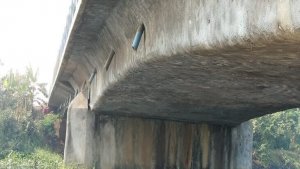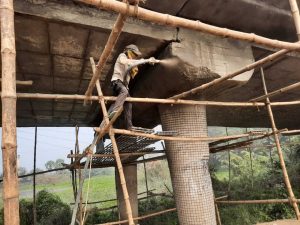Nondestructive Testing of Concrete (NDT):
Nondestructive testing of concrete (NDT) is a testing method used by industry to determine the concrete compressive strength, defects and discontinuities without causing damage to the original part of an existing structure.
Nondestructive Testing of Concrete Objective:
The test aims to assess the strength and other properties and to locate and obtain corresponding results showing permeable areas, cracks or laminations and areas of lower integrity than the rest.
List of Nondestructive Testing Methods:
Various methods of nondestructive testing of concrete have been developed and are under development for examining different properties of concrete in addition to the necessary visual inspection.
It is essential to highlight that it is unnecessary to carry out all the nondestructive testing of concrete in each case except the most relevant ones. In this section, we will discuss the following nondestructive testing methods.
- Rebound Hammer Test
- Ultrasonic Pulse Velocity Test
- Covermeter Test
- Carbonation Test
- Concrete Core Cutting Test
- Half Cell Potentiometer Test
- In-situ permeability Test
- Pull out Test
- Windsor Probe Test
Also, Read: Rusting of Iron Rebar in Concrete – Special Repairing

Also, Read: Blowholes/Surface voids/Bugholes in Concrete Surface
Concrete Rebound Hammer Test:
Generally, Schmidt concrete test hammer is used for conducting the concrete rebound hammer test, which is nondestructive testing of concrete. The test is a beneficial and quick procedure where we can get a clearer idea about the compressive strength of existing concrete of a particular structure.
- The main principle of the test is based on the elastic mass rebound theory. The elastic mass rebound depends on the hardness of the existing concrete from where the mass impinges.
- A spring-loaded mass has a fixed amount of energy imparted by extending a spring to a fixed position, and it is performed by pressing the plunger against the surface of the existing old concrete under test.
- Upon release, the mass rebounds from the plunger, still in contact with the concrete surface.
- The distance travelled by the mass, expressed as a percentage of the primary extension of the spring, is known as the rebound number; it is shown by a rider moving along a graduated scale.
- The test surface is prepared by rubbing the concrete surface with a carborundum stone.
- Approximately ten hammer readings are noted around the test points. The test is conducted as per IS:13311(Part 2)-1992.

Also, Read: Causes, Prevention and Repair of Concrete Surface Defects
The following figure represents the relationship between the Hammer Rebound number and the Strength of Concrete.


Also, Read: Bridge Inspection Types – Objectives and Guidelines
Ultrasonic Pulse Velocity Test:
The ultrasonic pulse velocity test, which is nondestructive testing of concrete, provides information regarding the strength and uniformity of concrete. It can also be used to detect and localize concrete voids, honeycombs, delaminations, cracks and defects.
- The ultrasonic pulse velocity test on concrete is conducted by the portable ultrasonic nondestructive digital indicating tester (PUNDIT), and where Pundit offers the most versatile range of ultrasonic testing instruments.
- PUNDIT is a highly accurate pulse time recording system and has a good reputation all over the world.
- The ultrasonic pulse velocity method measures the time of travel (in microseconds) of an ultrasonic pulse passing through the concrete to be tested.
- One transducer is used to transmit the pulse and the other to receive the pulse. The distance the pulses travel in the concrete (i.e. the path length) is also measured.
- The pulse velocity is determined from the following relationship:
- Pulse velocity = (Path length) / (Transit time)
- Depending upon the arrangement of transducers, the pulse velocity tests may be Direct, Semi Direct or Indirect.
- The most accurate method is a direct transmission that places the transducers on opposite faces.
- The accuracy of transit time measurement depends on the good acoustic coupling between the transducer face and the prepared concrete surface.
- The test surface is prepared by rubbing the concrete surface with carborundum stone and cleaned subsequently.
- A light grease is applied as coupling that helps the transmission of ultrasonic energy from the transducer into the test specimen/existing structure.

Also, Read: Concrete Ingredients – Important Properties and Tests
Pulse Velocity Ratings for Concrete:
As per table-2 of IS 13311 (Part 1): 1992 gives generalized Pulse Velocity Ratings for Concrete which are as follows:
Pulse Velocity (Km/Sec) | General Conditions |
Above 4.50 | Excellent |
3.50-4.50 | Good |
3.00-3.50 | Medium |
Below 3.00 | Doubtful |
The above may be taken as guidelines for assessing the structure’s condition. Any weakness in the form of cracks, voids, and weak concrete will result in lower pulse velocities.
Nondestructive testing of concrete, Covermeter Test:
The covermeter test is nondestructive testing of concrete conducted using the cover meter. The cover meters are magnetic devices, and the functions are based on the principle that the presence of steel affects the field of an electromagnet.
- The probe unit in a typical cover meter consists of a U-shaped magnetic core on which two coils are mounted.
- When an alternating current is passed through one of these coils, the current induced in the other coil is measured.
- The induced current depends upon the mutual inductance of the coils and the nearness of the steel reinforcing bars.
Half-Cell Potentiometer Test:
Half-Cell Potentiometer testing is adopted to determine carbonation depth and chloride penetration. This nondestructive testing of concrete helps to determine the probability of rebar corrosion within reinforced concrete structures.
- A half-Cel Potentiometer survey is conducted using the CANIN system, which allows a rapid, comprehensive site test and provides a quick assessment of the locations where corrosion is likely to occur.
- Detailed analysis of the data is made easy with the Canin ProVista software, and the new Wheel Electrodes (1 and 4-wheel versions) allow high-speed measurements of large areas.
- The corrosion of steel in concrete is an electrochemical process. It represents a galvanic element, similar to a battery producing an electric current and measurable as an electric field on the surface of the concrete.
- This potential field can be measured with an electrode known as a Half-Cell (copper/copper sulphate). By making measurements over the whole surface, a distinction can be made between corroding and non-corroding locations.
- A high impedance digital voltmeter is used to collect the data. An electrical correction is made to the steel either by exposing it or using already exposed steel.
- The foam rubber plugs saturated with water are pressed on the concrete surface at the pre-selected grid points, and the readings in millivolt (mV) are recorded.
Also, Read: Maintenance of Bridges – General Planning & procedure
Potential in the Millivolt(mV) and Corrosion Condition Relation:
The ASTM criteria for corrosion of steel in concrete for copper/copper sulphate Half-Cell are as follows:
Millivolt (mV) | General Conditions |
>-200 | Low(10% risk of corrosion) |
-200mV to – 350mV | Intermediate corrosion risk |
<-350 | High (more than 90% risk of corrosion) |
<-500 | Severe corrosion |
Carbonation Test:
Carbonation in concrete is a chemical process where atmospheric carbon dioxide reacts with the lime and other alkaline materials in the concrete and produces calcium carbonate. The above nondestructive testing of concrete helps to understand the extent of carbon dioxide infiltration into the concrete member.
- Loss of alkaline protection against reinforcement corrosion due to carbonation of concrete affects the serviceability of the structure.
- The atmospheric carbon dioxide reacts with hydrated cement compounds causing a reduction in the alkalinity of concrete.
- The depth of the carbonation is measured with the help of spraying a solution containing 0.1% of phenolphthalein on the freshly broken concrete surface.
- After application, the concrete undergoes a distinct colour change from purple-red to colourless if any carbonation of concrete occurs. Thus the carbonation of concrete is checked at the particular depth of existing concrete.
Nondestructive testing of concrete, Core Cutting:
The concrete core test is necessary for the existing structure condition survey, and when laboratory cube test results are not satisfactory, the Core test on concrete is performed. The core cutting test method is also under nondestructive testing of concrete.

Also, Read: Environment Health and Safety(EHS)
- In the Concrete Core test, the sample or core is collected from the existing concrete and extracted using the core cutting machine and then these cores are used to determine the concrete compressive strength.
- A portable core drilling machine is generally used for core cutting of existing concrete structures. It has a drill feed assembly which consists of a feed assembly, a screw assembly, a flange assembly, a drill shaft and a water jacket arrangement with the diamond core bit.
- One portable electric hammer drill machine is used to rotate the drill feed assembly.
- The core drilling machine is fixed by means of clamping pliers at the selected test locations after scanning the embedded reinforcements by the rebar locator instrument.
- The portable hammer drill is connected to the machine to start the drilling operation.
- Continuous water circulation has been maintained throughout the drilling operation for proper lubrication etc.
- Concrete cores of 50mm/68mm dia are collected, and simultaneously the concrete carbonation is checked at that particular location.
- Core Compressive Strength:
- The samples are stored in water for two days prior to compressive strength testing(as per IS:516) and are tested in a moist condition.
- If required, the ends of specimens are flattened and capped with molten sulphur or high alumina cement to obtain a truly flat surface.
- Concrete in the member shall be considered acceptable if the average equivalent cube compressive strength of the cores sample is equal to at least 85% of the cube strength of the grade of concrete specified and no individual core has strength less than 75%.

Also, Read: Crane Lifting Safety Procedure- Hazards & Control Measures
In-situ permeability Test:
The in-situ permeability test is a method under nondestructive testing of concrete. Because of the increasing instances of corrosion in reinforced/prestressed concrete structures, attention has been drawn to the significance of permeability in addition to compression strength in assessing the quality of concrete.
- The procedure consists of drilling a small hole in the concrete, sealing it with a rubber stopper and then evacuating the air from the hole with a vacuuming pump connected to a manometer.
- The rate at which the manometer recovers is a measure of the permeability of concrete.
- This method can be used to assess the resistance of concrete to carbonation, penetration of aggressive ions and quality of grout in post-tensioned ducts.
Pull Out Test:
The pull-out test method is nondestructive testing of concrete that may be used to assess the compressive strength of existing concrete.
- The test is considered to be superior to the rebound hammer test.
- However, the disadvantage is that slight damage to the concrete created in the test is required to be repaired.
Windsor Probe Test:
The above nondestructive testing of concrete is generally conducted to determine the concrete hardness of the existing structure. With the Windsor Probe Test, we can also determine the relative strength of concrete in different structures. We have to remember the test does not give absolute values; further confirmation is required to assess the actual condition.
Nondestructive Testing of Concrete Report:
- Based on the inspection report, a maintenance scheme, including remedial measures, shall be framed after a detailed study, as mentioned.
- The studies should reflect a detailed analysis of the cause of defects, deficiencies, construction faults, any supernatural effects, etc.
- After the finalization of maintenance criteria, the maintenance team will prepare a necessary drawing, bill of quantities, tender document, and complete maintenance report for maintenance work and will submit these to the higher authority for scrutinizing/comments.
- On approval of the maintenance scheme, the maintenance works shall be executed by the maintenance team or specialized agency appointed through tender.
Also, Read: Inspection of Bridges – Procedure & General Guidelines





